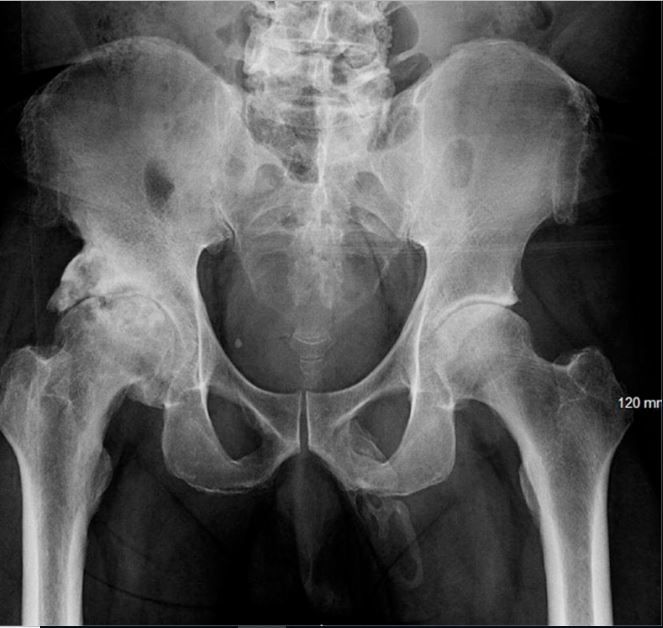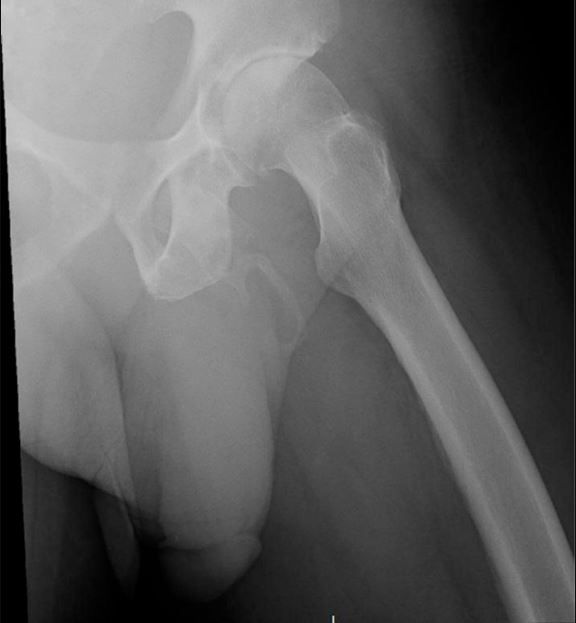Sometimes, the body grows bone in places it shouldn’t.
That was the case for a man diagnosed with penile ossification, a extremely rare condition in which bone forms inside the penis.

OMG! The poor guy! His penis is getting hard… Yes bone hard!
As explained by the Journal Urology Case Reports:
The 63-year-old man went to the emergency room after he fell on the sidewalk onto his buttocks. He was able to walk, but he told doctors he was experiencing knee pain.
When doctors performed a physical exam, the man also reported penile pain. Given that the man had fallen on his butt, doctors decided to first X-ray his pelvis to check for bone fractures. That’s when they noticed something very strange: The man appeared to have “ossification” along the entire shaft of his penis. In other words, bone had formed inside the penis.
Rare Case of Penile Ossification
The man was diagnosed with “penile ossification.” The condition is very rare, with fewer than 40 cases reported in the medical literature.
Ossification happens when calcium salts build up in soft tissues, “leading to bone formation in areas of the body where there is connective tissue.”
Exactly why this happens isn’t always clear. But doctors know that penile ossification, though rare, is often linked with another condition called Peyronie’s disease, which occurs when scar tissue builds up in the penis, causing the organ to bend or curve. This condition can also cause penile pain with or without erections.
Other possible causes can include metabolic diseases, end stage kidney disease or trauma.

Treatment for penile ossification depends on the extent of bone formation and the patient’s symptoms. Men who don’t have any symptoms typically don’t need treatment right away. But those with bothersome symptoms, such as pain, may be prescribed painkillers or receive injections in the penis with certain drugs to reduce pain or curvature. In severe cases, men may need surgical treatment.
This reminds me of the the baculum (also penis bone, penile bone, or os penis, or os priapi). This bone is found in the penis of many placental mammals. It is absent in the human penis, but present in the penises of other primates, such as the gorilla and chimpanzee. Is this guy undergoing a mutation?
Read more:
- https://www.sciencedirect.com/science/article/pii/S2214442019301925#bib4
- https://www.ncbi.nlm.nih.gov/pmc/articles/PMC5434841/
- https://www.livescience.com/man-penis-turning-to-bone.html













In 2019, Can PRP and Penile Traction Device Replace Collagenase to Treat Peyronie’s Disease?
— Peyronie’s disease (PD) is an accumulation of collagen in the penis that creates a scar, producing a deformity and pain in the erectile state, that affects between 1%-8% of men. ANDROMEDICAL laboratory proposes a new strategy to treat PD based on combined therapy of platelet-rich fibrin matrix (PRFM or activated-PRP) with Andropeyronie, a penile traction device (PTD) designed to treat penile curvatures. Now urologists, their patients and health insurance companies may have a cost-effective alternative to collagenase and surgery for effectively treating Peyronie’s disease, without side effects of other therapies. More information
In 2013 the US-FDA approved the use of collagenase (CCH) for its treatment. Collagenase is an enzyme that breaks the peptide bonds of collagen, but medical studies showed that effectiveness was limited to a 33% correction of penile curvature. In 2013, Dr. Martínez-Salamanca (Spain) carried out a hospital study with the penile traction device called Andropeyronie to treat Peyronie’s disease in the acute phase, achieving a 60% correction of the curvature. In 2015 the American Urological Association recommends treating Peyronie’s disease with combined collagenase therapy and Peyronie’s plaque remodeling, done with manual exercises or with a soft progressive force for a few hours a day with a penile traction device (PTD). Medical protocol
In 2018 Dr. Terlecki (USA) published a clinical study on the use of autologous platelet-rich plasma (PRP) in Peyronie’s disease whose conclusions were that the activated-PRP or PRFM appears to be a safe and feasible treatment, more than 80% of patients improved in their degree of curvature. Evidence suggests that platelets play an important role in tissue repair, vascular remodeling and inflammatory and immune responses through secretion of growth factors, cytokines and chemokines. Thus, injection of PRFM could combine mechanical disruption of the plaque, via needle fracture, while simultaneously neutralizing destructive inflammatory processes in an effort to promote a better wound-healing response and stabilize the disrupted plaque. It is important to note that collagenase injection does not address appropriate wound healing or regeneration of the damaged tissue. Clinical study
In 2013 Dr. Chung (Australia) demonstrated that penile traction translates mechanical stimuli into a chemical response leading to activation of cell proliferation. In 2019 Dr. Romero (Spain) published a clinical study demonstrating that the use of a penile traction device reduces the need of cycles of collagenase in patients with Peyronie’s disease. Clinical studies
The world of urology is advancing rapidly and clinics are beginning to use this promising combined therapy of platelet rich plasma with penile traction therapy in hopes of wound healing and tissue regeneration. New treatment options for Peyronie’s disease are opening up, with benefits for patients, urologists and health insurance companies. Therapy of PRP with PTD is an effective treatment without side effects, easily performed in the doctor’s office and a cost-effective alternative to other therapies.